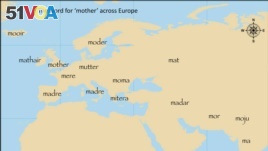August 24, 2012
The beginnings of the English language are rooted in Turkey, a new study suggests.
The Indo-European language family - which includes English, French, Russian, Persian and even ancient Greek - is one of the world’s largest language groups and extends from Iceland in the West to Sri Lanka in the East.
The common origin of all those languages, scientists say, must be somewhere on the European continent.
One hypothesis suggests it emerged 6,000 years ago from a semi-nomadic horse-riding people in the Russian Steppes north of the Caspian Sea.
Another says it is much older and came from what is now Turkey, spreading as agriculture did between 8,000 and 9,500 years ago.
Writing in Science, an evolutionary psychologist at the University of Auckland in New Zealand expresses support for the second theory. Quentin Atkinson's team worked in much the same way that evolutionary biologists do, using DNA to determine the origin of virus outbreaks.
“They use the DNA to reconstruct the family tree of the viruses. But rather than looking at viruses, we were looking at languages," he says. "And rather than looking at DNA, we were looking at the words in the different languages.”

People in Columbo, Sri Lanka, shown here making offerings to the Buddha, are part of the Indo-European language group which also includes English and Germanic languages. (Creative Commons Original Nomad)
The study analyzes 200 cognates or words with shared meanings and similar sounds across 103 languages, including 20 that are now extinct.
Atkinson says examining the similarities and differences helped establish family ties.
“For example, in English and other Germanic languages, the word for 'water' sounds something like the English word 'water,' or 'wasser' [in German], 'water' [in Dutch], whereas in the romance languages descended from Latin, the word sounds quite different, something like 'agua' [in Spanish] or 'acqua' [in Italian].
According to Atkinson, although some words are more closely related than others, they are tied together on branches of the Indo-European family tree.
“We know where the languages are," he says. "They are like the leaves of the tree, and we know how they are connected, and we trace back along those branches back through time and space to work out where the origin is.”

(Click to enlarge) This map shows the distribution of words across Europe for ‘mother.' By modeling the evolution of hundreds of such words through time, we can infer relationships between all the languages and trace back to the origin of the family. (Q.D. Atkinson)
The ancient Indo-European family today includes several hundred related languages, including those spoken in Europe, the Iranian plateau and South Asia. Atkinson says agricultural expansion is confirmed in the archeological record.
“So the argument is that agricultural populations were able to increase their population density relative to hunter gatherer populations around them, and so they expanded out generation by generation.”
Atkinson says the method used to study Indo-European family origins could be applied to other language groups. The analysis, he adds, “allows us to peer back into the past in a way that wasn’t possible before.”